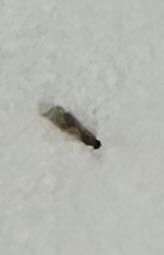Fungus Gnat Larva
Scientific Name: Bradysia spp. (common genus)
Order & Family: Order Diptera, Family Sciaridae (dark-winged fungus gnats) or Mycetophilidae (fungus gnats)
Size: Typically 1/4 to 1/2 inch (6-12 mm) long as larvae.

Natural Habitat
Damp, moist environments, especially in soil rich in decaying organic matter. Commonly found in potted plants, greenhouses, and areas with moisture issues.
Diet & Feeding
Primarily feed on fungi, decaying organic matter, and plant roots, especially fine root hairs. They can damage seedlings and young plants.
Behavior Patterns
Larvae are worm-like and translucent with a distinctive black head capsule. They live in the top layers of moist soil. Adults are small, dark, mosquito-like flies that emerge from the soil and are attracted to light and moisture. The entire life cycle from egg to adult can be as short as 3-4 weeks.
Risks & Benefits
Risks: Can be a nuisance in homes and greenhouses. Larvae can damage plant roots, leading to wilting, stunted growth, and even plant death, especially in young or stressed plants. Benefits: As decomposers, they contribute to the breakdown of organic matter in natural ecosystems, outdoor environments.
Identified on: 11/9/2025